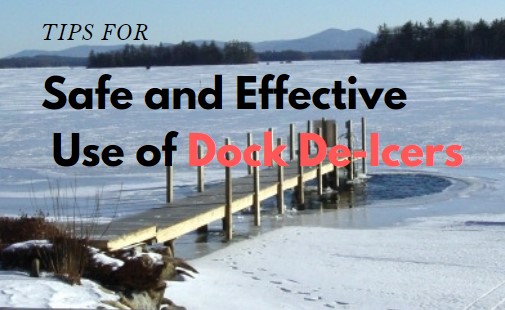
In an effort to protect permanent docks from ice damage, many property owners use a mechanical/electrical device that keeps ice from freezing around a dock or crib structure. These devices provide an ice free zone at your lakefront property by moving water in much the same way as a flowing stream does. If not properly managed or installed these devices can create larger than necessary open water areas and thin ice that are unsafe for recreation during the winter months. These large open water areas can also lead to greater ice damage to a dock. Courtesy of LSPA.
Types of de-icers
There are two common types of de-icing devices:
Bubbler: This device works by releasing small air bubbles from a submerged perforated hose(s) powered by an air compressor typically located on your dock or inside a boathouse. Bubbler de-icers don’t stir up lake bottom sediment and are less likely to cause dangerous thin ice conditions. Agitator/Circulator: This device works by circulating the water near the lake bottom toward the surface. The entire device is submerged in the water and contain a fair amount of lubricating oil that can leak directly into the water from failed seals. These devices need to be used with a timer, to limit the amount of open water.
Installation Tips:
♦ Complete a town application and post a sign (required by law; RSA 270:33) that is visible warning of open water and thin ice conditions. ♦ When purchasing or replacing a de-icer, choose the smallest size possible to maintain an ice free zone around your dock. ♦ Set up your de-icer to form a narrow open water area around your dock (a bubbler device works best). ♦ If using a circulator type of de-icer, be sure to point it in a vertical direction not at an angle to wards the middle of the lake as dangerous thin ice conditions will likely occur. ♦ Use a thermostat and timer to run the de-icer device only when air temperature drops below the freezing point and for a few hours a day. (2-4 hrs.).

Negative Impacts of a De-Icer Device
The following are some potential negative impacts associated with the use of de-icing devices:
♦ Many de-icing devices open too large an area causing dock damage by allowing ice floes more room to accelerate in windy conditions. ♦ Lake water temperature and light conditions are altered which may impact algae and plant growth, and alter feeding habits of fish and other aquatic organisms. ♦ Circulator de-icers can disturb bottom sediments releasing nutrients such as phosphorus, increasing algae. ♦ Large open areas are a safety hazard and can significantly reduce or prohibit winter recreation opportunities. ♦ De-icer devices are expensive to buy and operate and do not guarantee less ice damage. ♦ Circulator de-icers are noisy. These impacts are compounded when many de-icing devices are in use around the lake.
Size & Cost of Use Comparion
This cost comparison is approximate. Many units include a thermostat and/or a timer as an option. If a thermostat and/or timer are used, operating costs will be reduced. A device that runs only 2 – 4 hours a day will significantly reduce operating costs.

Looking to purchase a de-icer for your lakefront home? Check out Weeder’s Digest here: https://weedersdigest.com/de-icers/
Posted by Scott Freerksen “The Lake Guy”
